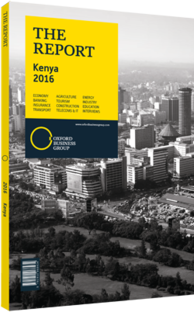Kenyan airports boost capacity and airline access
The opening of a new international terminal in late 2014 – Terminal 1a, built at a cost of $129m – and of a second, smaller terminal in May 2015 collectively tripled annual capacity at Nairobi’s Jomo Kenyatta International Airport (JKIA), from 2.5m to 7.5m passengers. JKIA has been operating above capacity for well over a decade. Passenger traffic at the airport grew by 127% between 2002 and 2011, according to the Kenya Airports Authority (KAA), which estimates that annual passenger numbers will hit nearly 35m by 2030.
Doors Open
Terminal 1a was opened after a fire in August 2013 destroyed the former international arrivals terminal, which has been demolished and cleared. The new terminal will be used exclusively by Kenya Airways and its Skyteam partners for all of their domestic and international flights. Terminal 2, a prefabricated facility that was built in six months, will handle most of the remaining domestic and some of the regional passengers, but is only a temporary measure while another larger terminal is built. The planned new terminal, which is expected to cost KSh56bn ($616m), is slated to be completed by 2017 and when finished, on its own, should boost passenger capacity at JKIA by 20m travellers. The temporary terminal, meanwhile, was built at a cost of KSh1.7bn ($18.7m), KSh600m ($6.6m) less than the original budget, and financed by the African Development Bank.
New Terminal
According to the KAA, a proposed third terminal, the Greenfield Terminal, will span an area of 178,000 sq metres and when completed would raise JKIA’s annual passenger capacity to 18.5m by 2030. With China’s Anhui Civil Engineering Group and China National Aero-technology International Engineering Corporation as lead contractors, the terminal project is being carried out as a public-private partnership through a financing consortium led by the African Development Bank, which finished an environmental impact assessment in February 2015.
Runaway Growth
The terminals are not the only infrastructure currently being overhauled. In early 2015 the KAA announced that the sole runway at JKIA, which was last resurfaced in 1992, would be closed for upgrades – including rehabilitation of the taxiways and apron – from 12am until 6am daily for a period of at least eight months. Both cargo and passenger airlines must reroute or reschedule affected flights. A long-awaited new, second runway is also on the cards: the National Environment Management Authority was expected to complete its impact review of the KSh13bn ($143m) project by April, though as of October no announcement had yet been made.
Bigger Picture
These upgrades form part of a broader programme to modernise and rehabilitate aviation infrastructure across Kenya. With improved airport infrastructure and connectivity a crucial part of the government’s Vision 2030 plan, airports in Mombasa, Kisumu, Malindi and Lamu will also see sizeable investments, as will smaller airstrips in rural areas. In all, investments worth about $150m have been made in improvements over the past few years.
Procedural Changes
A final piece of the puzzle will be set when Kenya can begin making direct flights to the US. JKIA is currently updating its security arrangements for passenger and freight traffic, as it continues to make the case for direct flights to the US after it cancelled plans to restart them six years ago. During a security audit by the US Federal Aviation Authority in April 2015, JKIA came “very close” to the 80% compliance mark required for such flights to begin, according to Samuel Poghisio, board chairman of Kenya’s Civil Aviation Authority. He told local media in May he expects JKIA to pass a final review by late 2015.
You have reached the limit of premium articles you can view for free.
Choose from the options below to purchase print or digital editions of our Reports. You can also purchase a website subscription giving you unlimited access to all of our Reports online for 12 months.
If you have already purchased this Report or have a website subscription, please login to continue.

